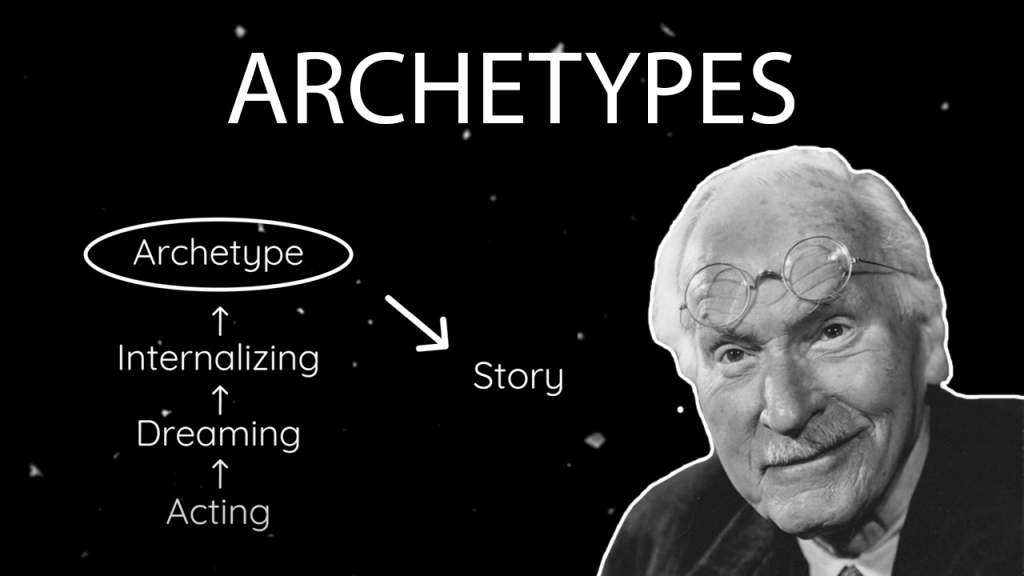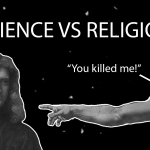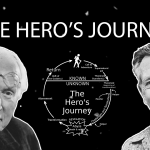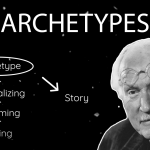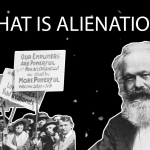Intro
(Watch the full video on YouTube by clicking here.)
Without knowing any context, without any words, most of us are able to know what the story was about that you just saw. [Clip from Hercules]
First, there is the beginning, the blissful introduction of the Hero.
But then something, unpredicted and unfortunate happens
Then there is a battle with evil, often visualised in a sort of hell, it is chaos, not knowing if the hero will survive
And then finally, the return of the Hero, after glorious victory.
He has defeated evil, he has risen to the status of a true Hero.
But why do we watch and listen to these stories?
And how is it that without any context or words, we know what the images mean?
Why do many people say that the biblical stories cannot be “real”, but then go an to watch talking animals for 1.5 hours like it’s the most normal thing in the world?
Why do we create these talking animals in the first place?
There are hundreds of these questions, and they all show that we do not understand ourselves as good as we think we do.
The most important question that we will answer in this series is: Who and what are we from a psychological perspective, and how can stories myths and legend help us in the understanding of our own being?
We will encounter questions of morality, how to combat chaos (something that we all are confronted with at some point in our lives), mythical experiences and much more.
There will be some introductory videos like this one, before diving into the history and actuality of story, myth and legend.
These videos will first explain some fundamental concepts which will give the psychological foundation that can help us in understanding these profound and sacred stories.
In this first video, we will take a look at the concept of Archetypes.
So without further ado, lets get into the video.
In the Beginning
Let us start at the beginning.
Imagine us humans as primal beings, living in some desert or rainforest.
We know by trial and error what works, and what gets us killed:
we have learned for example, to fear snakes becouse this was one of the biggest threads to us primates when we still lived in trees.
We even adopted biologically to combat the dangers of snakes by developing special aye sight
This eyesight lets us spot “things” that look like snakes, so for example, you walk in a forest and your ayes spot a stick on the ground.
You will freeze without even knowing what it is yet that you froze for, before noticing it is a stick instead of a snake, it has become a reflex.
A very useful reflex to be sure, becouse if it were a real snake you would not like to have stepped on it.
This reflex is also called the orientation reflex. It is the moment your brain knows something is wrong, but you do not know yet what it is, or how to act for that matter.
It is unconcious.
In biological terms, this is the moment before deciding to fight or flight.
Okay, so now we know what works and what not, what gets us killed, but how do we make sure that others do not need to make the same mistakes we made?
This is where primitive people engage in rites and play to enact the trials that previous people had endured.
This is also where Totems and Taboos come in for example, as described by Freud.
For example, in primitive people, totems are used to distinguish between different families to prevent incestuous relations between family members.
Here totems are these long wooden poles with animals at the top, as seen in many children movies for example.
The reason for these Totems is becouse the primitive people noticed the negative effects of these relations within families, as we now well know is due to genetic defects in the process of conception.
I think it is just amazing how these primitive people, us, thousands of years ago, firstly figured out that there is a problem, and that they then build these elaborate systems to prevent these bad things from happening.
However, the creation of these totems does not mean that this is true conscious behaviour per se, that they know what the problem is.
It still is dominated by trial and error and largely unconcious.
They just acted on their impulses, which returned negative effects, and hence a totem was made to prevent the act itself.
They only act out what they have learned, but if you were to ask them why they build the totems they would not know the exact reason.
And most often this is where the authority of God comes in to fulfil the role of a reason.
The funny thing is, that the same behaviour in primitive people can be seen in the play of children, as noticed by psychologist Jean Piaget.
For example, in observing children playing with marbles. During the game, there are certain rules. And all children enact these rules, even though most are made up as they play.
However, if you were to ask one child what the rules were, they would not know, yet the game could be played.
The child could act, but was not yet able to make an abstract representation of what he was doing.
It is only after the enactment of rites and games that we can begin to see the patterns that emerge across different games.
The observation of these patterns can be seen as the internalisation of the observed behaviours, we become Conscious.
Now with an increasing consciousness, we are able to look at more and more games.
What we then can do, is look at the commonalities between the different games.
And what we hence would observe, would be the meta-game of all games.
What then emerges is what Carl Jung called: Archetypes.
Just as an example of an archetype, I personally like the Mayan, Hindu and Norse representations of the world.
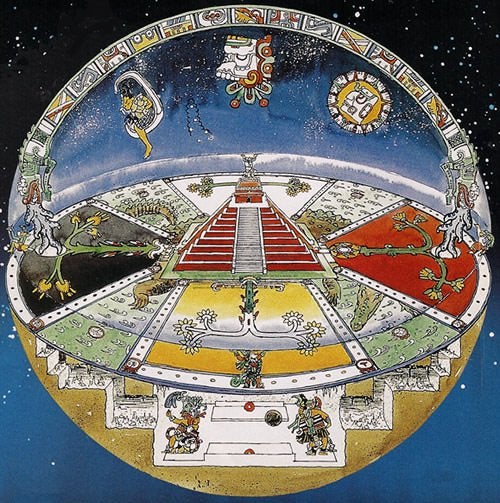
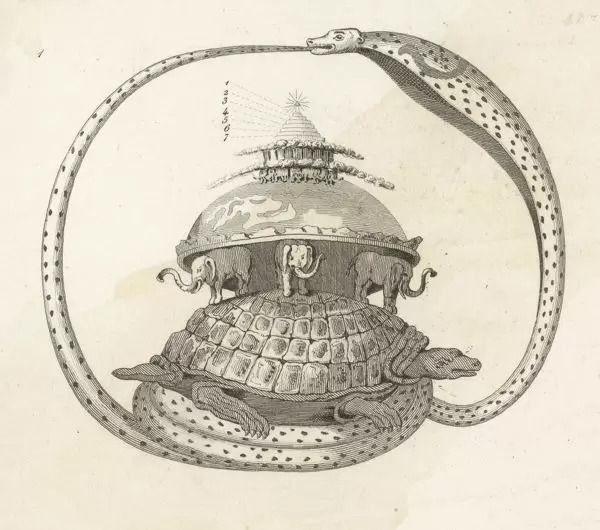
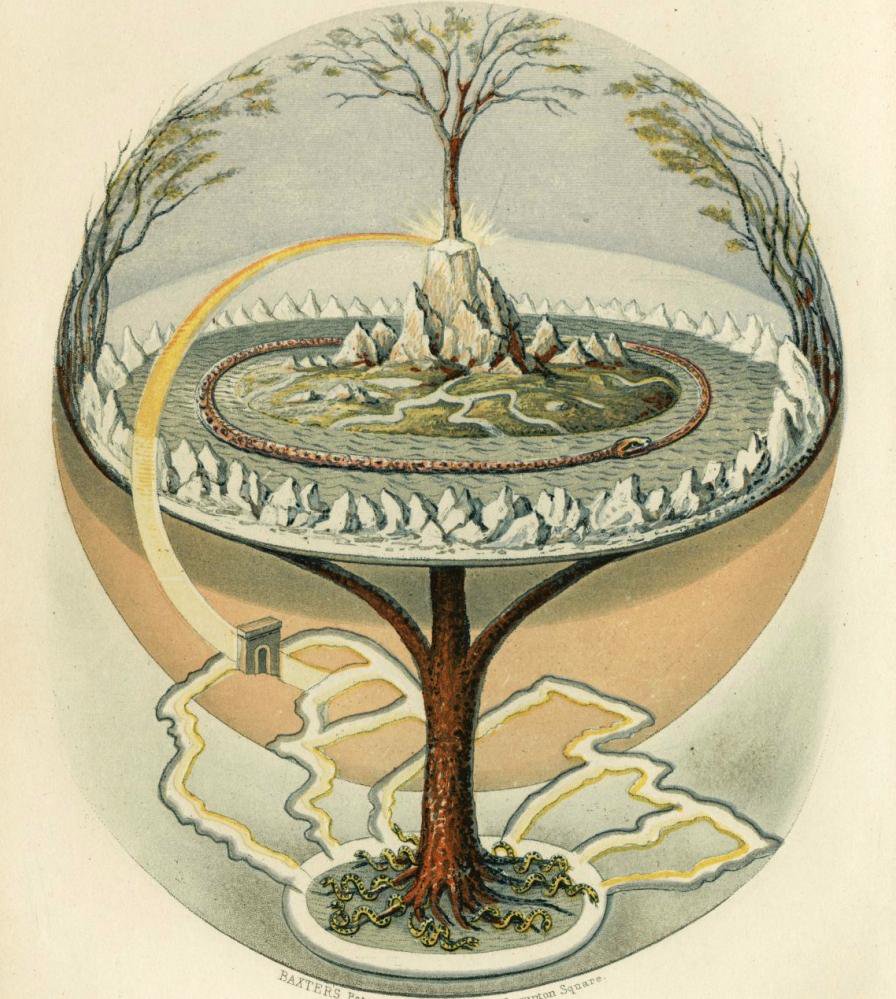
They all show the world as a sphere with something that is analogous to a heaven, the infinite sky with the stars,
But it also shows a hell. Here visualised using snakes or monsters, notice the snakes here again.
It furthermore shows the centre of the world, the Axis Mundi, eighter by the tree of knowledge, or by the temple of the Gods reaching into heaven.
What is even more amazing than the representation itself, is that these people never even met each other, they did not even know of the existence of each other.
Yet they came to the same representation of the world.
This implies that we humans do share some fundamental underlaying structures.
This is what Jung called: the Collective Unconcious.
It is the foundation of archetypes, it is something that we all have, even if we are not aware of the existence itself.
Now, even though Jung was the one that coined the term Archetypes, he was not the first to notice the principles behind the Archetypes and the collective unconcious.
It can also be seen in the writings of Nietzsche for example:
“In our sleep and in our dream we pass through the whole thought of earlier humanity. I mean, in the same way that man reasons in his dreams, he reasons when in the waking state many thousands of years. […] The dream carries us back into earlier states of human culture, and affords us a means of understanding it better.”
It is interesting to see here, the connection between the collective unconcious and the dream.
For who is the one that dreams your dreams? Certainly not you is it?
This is the foundation on which Freud build his legacy of psychoanalysis:
“Advances in psycho-analytic experience have brought to our notice patients who have shown a direct understanding of dream-symbolism of this kind to a surprising extent. . . . This symbolism is not peculiar to dreams, but is characteristic of unconscious ideation, in particular among the people, and it is to be found in folklore, and in popular myths, legends, linguistic idioms, proverbial wisdom and current jokes, to a more complete extent than in dreams."
There is however an important difference between myth and dream.
Here, dream is highly personal, but myth belongs to the universal.
Or as Joseph Campbell explains:
“Dream is the personalized myth, myth the depersonalized dream; both myth and dream are symbolic in the same general way of the dynamics of the psyche. But in the dream the forms are quirked by the peculiar troubles of the dreamer, whereas in myth the problems and solutions shown are directly valid for all mankind.”
Now, we have seen how games, or behaviour, can turn into archetype, but to go one step further, is to turn these archetypes into stories.
A good example of stories that describe behaviour that will help us survive in nature, are fairy tales.
Take the example of red riding hood:
Red riding hood is set out to her grandmother to deliver some food, but is explicitly warned by her mother, to not wonder of the path becouse of the big bad wolf.
Meanwhile the wolf has eaten the grandmother, as you do, and its now pretending to be the grandmother.
Red riding hood is fooled by the wolf in grandmothers cloths and gets eaten.
Luckily the huntsman arrives to save them and kill the wolf.
The moral of the story: Never disobey mothers rules, and watch out for “wolfs in sheep’s clothing”.
Now this might seem a harmless little story, but for children, this can have a profound psychological effect.
And even if we are unaware of these archetypes, we know unconsciously to not wonder off the path, and to watch out for charlatans.
So even if the story is not “real”, it is nonetheless “true” from a psychological perspective.
Now, where fairy tales are thus primarily concerned with behaviour, Religion is primarily concerned with the psychology and the morality of humans.
It tries to answer questions like: how do I not become depressed? or in biblical terms: how to not go to hell.
or how do I treat my fellow humans? What is Good and Evil?
These are fundamental questions, that most people nowadays do no longer have the answers to.
Especially since the death of God as observed by Nietzsche.
When we look at religious texts, virtually all are written in the same way.
First there is a summary text of the stories, archetypal stories that are thousands of years old, and then there is a part that gives some rules that offer the practical interpretation of these stories.
In the old testament for example, we start with the creation stories and the stories of the patriarchs in Genesis.
Followed by the story of Moses in Exodus. Here already some rules are expressed, the 10 commandments.
From Leviticus onward, the texts are primarily concerned with rite and law.
In general, the foundation of these stories starts with acting, from acting we can see certain patterns which we can begin to imitate.
After imitation we can begin to make the imitations abstract, and after abstraction it is made into stories which will consist of these archetypes.
The last step is to make rules out of these archetypes to ensure that the society is formed after the fundamental archetypes of our ancestors.
This archetype also explains our laws of today.
It is not that in the 17th century during the enlightenment, people just sat together and invented some new laws that we had to abide by.
No, the law that we have today is based on the same fundamental stories and archetypes that are expressed in religions, stories and myths.
We shall not steal, we shall not use violence and least of all… we shall not cheat.
This concept is also explained by Dante’s Inferno, where Dante tries to look at the layers of hell, to figure out what is the deepest Sin of all.
And there in the lowest level of hell, he finds betrayal.
And is this not exactly what betrayal feels like? Being betrayed…
The pain and suffering?
In the end, we first had to live these stories, make these mistakes, before they became rules. Trial and error.
Now it is ridiculous to make these old text and old life instructions our only authorities.
There are stories that do no longer apply in this day and age.
Or according to Joseph Campbell:
“The myth has to provide, just on this immediate level, of life instruction, the pedagogical aspect admit, it has to give life models and the models have to be appropriate to the possibilities of the time in which we are living. And our time has changed…, and it continues to change. […] If the world changes, religion has to be changed”.
Conclusion
Now, we have seen what the basic ideas are of stories and we have introduced the concept of archetype.
We have seen how actions are translated into stories, and stories into law as consciousness continues to expand.
But before going into the journey of the great stories, myths and legends of the past and present, there are some other concepts that we need to look at in these introduction videos in order to fully understand their significance.
The next video will explain the most prominent of all archetypes: The Heroes Journey.
For now, thank you for watching the video!
I hope you enjoyed watching it as much as I did making it.
I hope that something good happens to you today and to see you in the next video!

